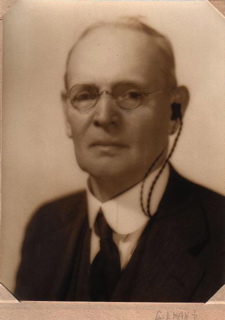Robert Grant Aitken facts for kids
Quick facts for kids
Robert Grant Aitken
|
|
|---|---|

Robert Grant Aitken (1864-1951)
|
|
| Born | December 31, 1864 |
| Died | October 29, 1951 (aged 86) |
| Other names | R.G. Aitken |
| Known for | Double Stars |
| Scientific career | |
| Fields | Astronomy |
| Institutions | University of California, Lick Observatory |
Robert Grant Aitken (born December 31, 1864 – died October 29, 1951) was an American astronomer. He was famous for studying and cataloging thousands of double stars. His work helped scientists learn more about how stars move and what they are made of.
Contents
Early Life and Education
Robert Grant Aitken was born in Jackson, California. His parents were Robert Aitken, who came from Scotland, and Wilhelmina Depinau. Young Robert went to Williams College in Massachusetts. He earned his first degree there in 1887.
A Career Among the Stars
After college, Robert Aitken taught mathematics in Livermore, California, from 1887 to 1891. He then received his master's degree from Williams College in 1892. Later, he became a math professor at the College of the Pacific.
In 1895, he got an exciting job offer. He became an assistant astronomer at Lick Observatory in California. This was where his most important work began.
Discovering Double Stars
Aitken started to study double stars very carefully. These are two stars that orbit around each other, like tiny dance partners in space. He measured their positions and figured out how they moved.
Starting in 1899, he worked with another astronomer, W. J. Hussey. Together, they began to create a huge list, or catalog, of these double stars. They published their findings in special bulletins from the Lick Observatory.
In 1905, Hussey left, but Aitken kept going with the project on his own. By 1915, he had found about 3,100 new binary stars! This was in addition to the 1,300 stars Hussey had found.
The Famous Star Catalog
All of Aitken's hard work led to a major publication in 1932. It was called New General Catalogue of Double Stars Within 120° of the North Pole. This book was a huge help to other astronomers. It contained information that allowed them to figure out the mass (how much "stuff" is in) a large number of stars. For this amazing work, he received the important Bruce Medal in 1926.
Other Astronomical Work
During his career, Aitken also measured the positions and paths of comets. He also studied the natural satellites (moons) of different planets. In 1908, he even joined a trip to Flint Island in the central Pacific Ocean to observe a solar eclipse.
He also wrote a book called Binary Stars, which was first published in 1918. A second version came out in 1935.
Leading Astronomical Groups
Robert Aitken was also very involved in the astronomy community. He joined the Astronomical Society of the Pacific in 1894. He was later chosen to be the president of this society twice, in 1899 and 1915. He also helped edit the Publications of the Astronomical Society of the Pacific for many years, from 1898 to 1942.
In 1932, he gave a special lecture called the Darwin Lecture to the Royal Astronomical Society. He was also an associate member of this group. From 1918 to 1928, he led the double star committee for the International Astronomical Union.
Personal Life
Robert Aitken had some hearing loss and used a hearing aid. He married Jessie Thomas around 1888. They had three sons and one daughter. Jessie passed away in 1943.
His son, Robert Thomas Aitken, became an anthropologist. He studied the cultures of people living on Pacific islands. His grandson, Robert Baker Aitken, was a well-known teacher and writer of Zen Buddhist ideas. His granddaughter, Marjorie J. Vold, was a famous chemist who studied colloids.
Honors and Recognition
Robert Grant Aitken received many awards and honors for his important work in astronomy.
- Awards
- Lalande Prize from the French Academy (1906, shared with William Hussey)
- Bruce Medal (1926)
- Gold Medal of the Royal Astronomical Society (1932)
- Rittenhouse Medal (1934)
- He also received honorary science degrees (Sc.D.) from the College of the Pacific, Williams College, and the University of Arizona. He received an honorary law degree (LL.D.) from the University of California.
- Named After Him
- A small planet, 3070 Aitken, was named in his honor.
- A crater on the Moon, called Aitken, is part of a very large area known as the South Pole-Aitken basin.
- The Aitken supercomputer at NASA Ames Research Center in California is also named after him.
See also
 In Spanish: Robert Grant Aitken para niños
In Spanish: Robert Grant Aitken para niños

